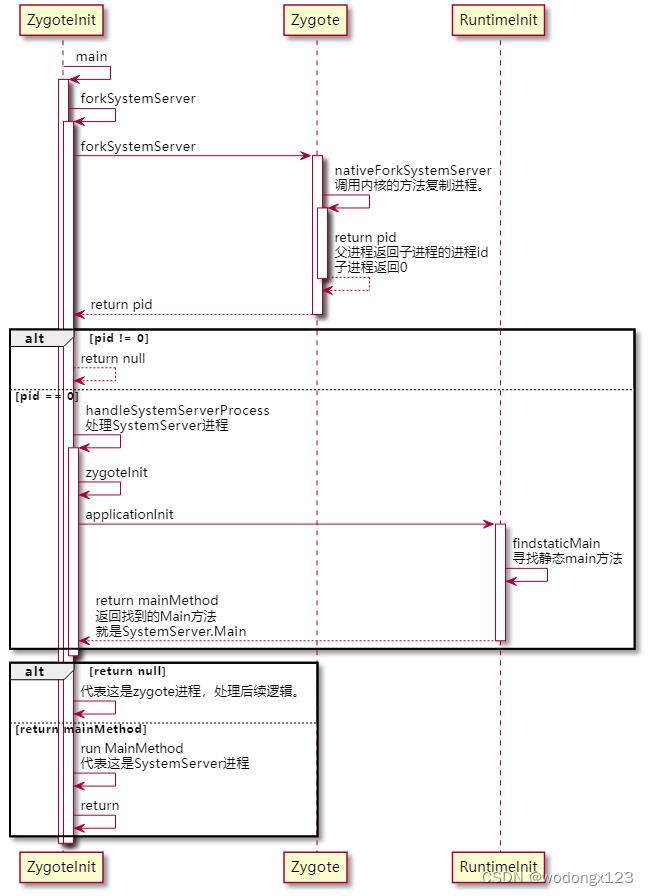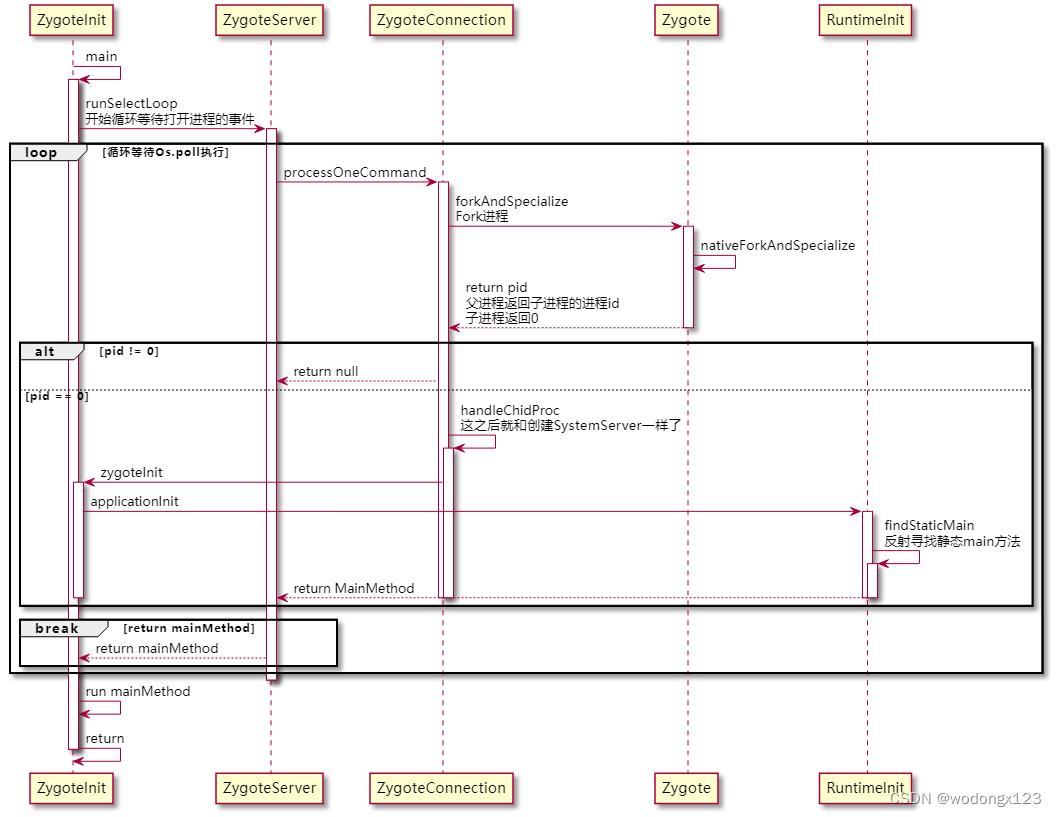Zygote进程原理简单介绍,源码解析
Posted wodongx123
tags:
篇首语:本文由小常识网(cha138.com)小编为大家整理,主要介绍了Zygote进程原理简单介绍,源码解析相关的知识,希望对你有一定的参考价值。
文章目录
1. Zygote介绍
我们的android系统是基于Linux系统,所以当我们开机的时候,第一个启动的是Init进程,而后面所有的进程都是Init的子进程,zygote就是Init进程通过解析init.rc文件之后,启动的一个进程
Zygote的进程的主要作用只有两个:
- 启动SystemServer进程。SystemServer是一个用于启动手机内部各种服务的进程,我们常说的PMS,AMS等都是由SystemServer所启动。
- 在系统运行过程中,即时的去孵化APP进程,也就是我们每次点击APP图标启动的APP的时候,zygote就开始运作了。
关于孵化:
Zygote进程创建别的进程的时候,用的不是创建,而是孵化这个词,那怎么理解孵化这个意思呢?
- 我们Android系统的程序,都是基于虚拟机所启动的,如果我们每次启动一个APP都要新启动一个虚拟机,那未免也太卡太慢了。
所以为了避免这种场景,zygote进程在启动的时候,就会直接预加载虚拟机所需要的内存等资源,等后面创建应用需要用到的时候,直接共享使用,这样就避免了多次启动虚拟机的情况。 - zygote进程在创建进程的时候,最后会调到Linux内核自带的的fork方法,来复制一个子进程,从而达到1所说的共享虚拟机内容的情况。
- zygote进程的作用,就是生成别的进程,自己是不负责做事的。
关于fork:
fork在zygote进程中是一个很重要的概念,这是Linux内核自带的一个方法,这个方法的作用就是复制一个子进程。那么,怎么理解这个复制的意思,简单来说,就是从成员变量,到内存空间,再到当前所执行的代码指令,都会生成一个副本后放到子进程中。
当进程A调用fork后,进程A和复制的子进程B,都会得到fork方法的return值,并且继续往下执行。
返回值: 若成功调用一次则返回两个值,子进程返回0,父进程返回子进程ID;否则,出错返回-1
进程A在开辟一块内存空间之后,持有这个内存空间的引用的话,在fork之后,子进程B也会持有这个内存空间。
2. fork进程源码解析
2.1 Native层启动Zygote进程
由于也不怎么做C语言的开发工作,这部分就快速略过,简单来说就是init进程在读取init.rc文件之后,根据文件里面的指令:
- 启动了虚拟机。
- 注册了JNI(Java Native Interface,也就是我们常看见的那些native方法啥的)。
- 启动了Zygote进程,具体启动方式就是通过反射,拿到ZygoteInit.java这个类,然后去调用里面的main方法。
2.2 启动SystemServer
我还是先搬出我的时序图,对这个启动过程先做一个总结。

fork生成SystemServer进程
public class ZygoteInit
public static void main(String argv[])
// 省略了无关代码
if (startSystemServer)
Runnable r = forkSystemServer(abiList, zygoteSocketName, zygoteServer);
// 如果返回的值不为空,就代表当前处于子进程,执行子进程找到的main方法
if (r != null)
r.run();
return;
private static Runnable forkSystemServer(String abiList, String socketName,
ZygoteServer zygoteServer)
// 省略了无关代码
int pid;
/* fork生成SystemServer进程 */
pid = Zygote.forkSystemServer(
parsedArgs.mUid, parsedArgs.mGid,
parsedArgs.mGids,
parsedArgs.mRuntimeFlags,
null,
parsedArgs.mPermittedCapabilities,
parsedArgs.mEffectiveCapabilities);
// 0表示当前是子进程,也就是SystemServer进程
if (pid == 0)
if (hasSecondZygote(abiList))
waitForSecondaryZygote(socketName);
zygoteServer.closeServerSocket();
return handleSystemServerProcess(parsedArgs);
// 非0表示当前是父进程,也就是Zygote进程
return null;
public class Zygote
static int forkSystemServer(int uid, int gid, int[] gids, int runtimeFlags,
int[][] rlimits, long permittedCapabilities, long effectiveCapabilities)
ZygoteHooks.preFork();
int pid = nativeForkSystemServer(
uid, gid, gids, runtimeFlags, rlimits,
permittedCapabilities, effectiveCapabilities);
// Set the Java Language thread priority to the default value for new apps.
Thread.currentThread().setPriority(Thread.NORM_PRIORITY);
ZygoteHooks.postForkCommon();
return pid;
/** 最后是调用了内核的fork方法来复制进程 */
private static native int nativeForkSystemServer(int uid, int gid, int[] gids, int runtimeFlags,
int[][] rlimits, long permittedCapabilities, long effectiveCapabilities);
这里就可以看出来,对于fork方法的基本处理,因为生成的进程和父进程唯一的区别就是return的值不一样,所以就根据这个return值来区分是父进程还是子进程,从而选择接下来要处理的逻辑。
SystemServer进程寻找main方法
从handleSystemServerProcess开始继续看。
public class ZygoteInit
private static Runnable handleSystemServerProcess(ZygoteArguments parsedArgs)
// 省略了无关代码
return ZygoteInit.zygoteInit(parsedArgs.mTargetSdkVersion,
parsedArgs.mDisabledCompatChanges,
parsedArgs.mRemainingArgs, cl);
public static final Runnable zygoteInit(int targetSdkVersion, long[] disabledCompatChanges,
String[] argv, ClassLoader classLoader)
// 省略了无关代码
RuntimeInit.commonInit();
ZygoteInit.nativeZygoteInit();
return RuntimeInit.applicationInit(targetSdkVersion, disabledCompatChanges, argv,
classLoader);
public class RuntimeInit
protected static Runnable applicationInit(int targetSdkVersion, long[] disabledCompatChanges,
String[] argv, ClassLoader classLoader)
// 省略了无关代码
return findStaticMain(args.startClass, args.startArgs, classLoader);
/**
* 找到className中的静态main方法
* 其实就是用反射去找类中的这个方法而已
*/
protected static Runnable findStaticMain(String className, String[] argv,
ClassLoader classLoader)
Class<?> cl;
try
cl = Class.forName(className, true, classLoader);
catch (ClassNotFoundException ex)
throw new RuntimeException(
"Missing class when invoking static main " + className,
ex);
Method m;
try
m = cl.getMethod("main", new Class[] String[].class );
catch (NoSuchMethodException ex)
throw new RuntimeException(
"Missing static main on " + className, ex);
catch (SecurityException ex)
throw new RuntimeException(
"Problem getting static main on " + className, ex);
int modifiers = m.getModifiers();
if (! (Modifier.isStatic(modifiers) && Modifier.isPublic(modifiers)))
throw new RuntimeException(
"Main method is not public and static on " + className);
/** 这个return的Runnable,最终会在ZygoteInit的main方法中被执行。*/
return new MethodAndArgsCaller(m, argv);
/** RuntimeInit中封装的Runnable,run方法就是去跑找到的method而已 */
static class MethodAndArgsCaller implements Runnable
/** method to call */
private final Method mMethod;
/** argument array */
private final String[] mArgs;
public MethodAndArgsCaller(Method method, String[] args)
mMethod = method;
mArgs = args;
public void run()
try
mMethod.invoke(null, new Object[] mArgs );
catch (IllegalAccessException ex)
throw new RuntimeException(ex);
catch (InvocationTargetException ex)
Throwable cause = ex.getCause();
if (cause instanceof RuntimeException)
throw (RuntimeException) cause;
else if (cause instanceof Error)
throw (Error) cause;
throw new RuntimeException(ex);
这段代码不难看出,SystemServer进程做的事,就是通过反射去找到SystemServer.java这个类的静态main方法去执行,同时将ZygoteInit的main方法给return了。
2.3 启动APP
启动APP主要是靠ZygoteServer类,这里还是先搬出时序图

看着有点小乱,主要是因为套了一个死循环方法。
class ZygoteInit
public static void main(String argv[])
// 省略无关代码
ZygoteServer zygoteServer = null;
Runnable caller;
try
zygoteServer = new ZygoteServer(isPrimaryZygote);
// SelcetLoop方法在fork之后的子进程中会return出一个caller
// SelectLoop方法会在Zygote进程中无限循环不停止。
caller = zygoteServer.runSelectLoop(abiList);
catch (Throwable ex)
Log.e(TAG, "System zygote died with exception", ex);
throw ex;
finally
if (zygoteServer != null)
zygoteServer.closeServerSocket();
// 执行子进程中return出来的Runnable方法
if (caller != null)
caller.run();
class ZygoteServer
Runnable runSelectLoop(String abiList)
// 省略无关代码
// 将SocketFD添加到列表头
ArrayList<FileDescriptor> socketFDs = new ArrayList<FileDescriptor>();
socketFDs.add(mZygoteSocket.getFileDescriptor());
while (true)
StructPollfd[] pollFDs = null;
pollFDs = new StructPollfd[socketFDs.size()];
int pollIndex = 0;
for (FileDescriptor socketFD : socketFDs)
pollFDs[pollIndex] = new StructPollfd();
pollFDs[pollIndex].fd = socketFD;
pollFDs[pollIndex].events = (short) POLLIN;
++pollIndex;
try
// 等待文件描述符上的POLLIN事件,代码会阻塞在这里直到响应之后才继续往下执行
Os.poll(pollFDs, -1);
catch (ErrnoException ex)
throw new RuntimeException("poll failed", ex);
while (--pollIndex >= 0)
// 如果没有实际发生的事件并不是可读事件就跳过该文件描述符
if ((pollFDs[pollIndex].revents & POLLIN) == 0)
continue;
if (pollIndex == 0)
// 创建一个连接
ZygoteConnection newPeer = acceptCommandPeer(abiList);
peers.add(newPeer);
socketFDs.add(newPeer.getFileDescriptor());
else if (pollIndex < usapPoolEventFDIndex)
try
// 获取Zygote连接
ZygoteConnection connection = peers.get(pollIndex);
// 获取一个方法,实际上就是获取子进程的静态Main方法
final Runnable command = connection.processOneCommand(this);
// 成员变量,当fork完子进程的时候,子进程会将该变量设置为true
if (mIsForkChild)
if (command == null)
throw new IllegalStateException("command == null");
return command;
else
//在主进程中关闭掉该连接
if (connection.isClosedByPeer())
connection.closeSocket();
peers.remove(pollIndex);
socketFDs.remove(pollIndex);
catch (Exception e)
这个代码看着其实和Looper.loop非常相似,都是先阻塞在一个地方,等到响应之后才开始继续往下处理。
文件描述符FileDescriptor
在runSelectLoop这个方法里面,会出现FileDescriptor或者FD,这个东西是文件描述符,我把百科的话简单提炼介绍一下:
就是我们每个进程在运行的时候,在虚拟机底层都会有个表(一段连续的存储地址),这个表专门用于记录我们每次打开文件时的信息,包括目标文件的地址,应用层对文件所进行的操作等信息。
每次在对文件进行打开操作的时候,我们都可以获得该文件在这个文件表的下标。这个下标就叫做文件描述符,我们可以根据这个下标通过LINUX系统的API来操作或者监听那些曾经被打开过的文件。
还想具体了解的话,见百科:https://baike.baidu.com/item/%E6%96%87%E4%BB%B6%E6%8F%8F%E8%BF%B0%E7%AC%A6/9809582?fr=aladdin
OS.poll
OS.poll,让runSelectLoop阻塞的方法,这个方法的底层调用,就是调用linux系统的poll方法,具体功能为:
等待文件描述符上的某个事件,具体等待什么事件,根据设置决定,看一下StructPollfd 这个对象
public final class StructPollfd
/** The file descriptor to poll. */
public FileDescriptor fd;
/**
* The events we're interested in. POLLIN corresponds to being in select(2)'s read fd set,
* POLLOUT to the write fd set.
*/
public short events;
/** The events that actually happened. */
public short revents;
其中,fd就代表了文件描述符,event代表了关注的事件,revent代表了实际发生的事件。
套入到我们的场景当中,我们等待的就是POLLIN这个事件,也就是可读事件。
创建连接
在if (pollIndex == 0) 中看一下如何创建一个连接,主要是acceptCommandPeer这个方法,所以就从这里看起
class ZygoteServer
private ZygoteConnection acceptCommandPeer(String abiList)
try
// mZygoteSocket的类型为LocalServerSocket
return createNewConnection(mZygoteSocket.accept(), abiList);
catch (IOException ex)
throw new RuntimeException(
"IOException during accept()", ex);
protected ZygoteConnection createNewConnection(LocalSocket socket, String abiList)
throws IOException
return new ZygoteConnection(socket, abiList);
public class LocalServerSocket implements Closeable
private final LocalSocketImpl impl;
public LocalSocket accept() throws IOException
LocalSocketImpl acceptedImpl = new LocalSocketImpl();
impl.accept(acceptedImpl);
return LocalSocket.createLocalSocketForAccept(acceptedImpl);
class LocalSocketImpl
protected void accept(LocalSocketImpl s) throws IOException
if (fd == null)
throw new IOException("socket not created");
try
//重点就是这行Os.accept
s.fd = Os.accept(fd, null /* address */);
s.mFdCreatedInternally = true;
catch (ErrnoException e)
throw e.rethrowAsIOException();
最后核心的部分是,调用了Os.accept,这个方法的功能简单来说就是,当调用Os.accept后,就会根据参数的fd创建一个新的Socket连接,并返回该连接的FD。
启动一个新的进程流程
综合一下前面的内容,我们就可以总结出这个死循环总体的功能了
- 在一开始的时候,我们对mZygoteSocket的FD监听POLLIN事件(此时socketFDs 列表里面只有mZygoteSocket对象)。
- 另一个进程A通过ZygoteProcess.connect这个方法,来创建一个连接并发出消息(此时调用了Os.socket,创建Socket连接)。
- Os.poll触发,此时一定是触发if (pollIndex == 0) 的条件,然后创建一个新的Zygote连接(此时调用了Os.accept)。
- 进程A通过在Zygote.connect这个方法的流程中,调用LocalSocketlmpl.connectLocal方法,确认连接。
- 然后第二次监听POLLIN的时候,socketFDs里面就有mZygoteSocket和我们在刚刚创建的新连接。
- 此时触发的是else if (pollIndex < usapPoolEventFDIndex) ,去fork一个新的进程,并且找到对应的main方法运行,子进程就算创建完成了。
附:时序图代码
@startuml
participant ZygoteInit as init
participant Zygote as zygote
participant RuntimeInit as rinit
init -> init : main
activate init
init -> init : forkSystemServer
activate init
init -> zygote : forkSystemServer
activate zygote
zygote -> zygote : nativeForkSystemServer\\n调用内核的方法复制进程。
activate zygote
zygote --> zygote : return pid\\n父进程返回子进程的进程id\\n子进程返回0
deactivate zygote
zygote --> init : return pid
deactivate zygote
alt pid != 0
init --> init :return null
else pid == 0
init -> init : handleSystemServerProcess\\n处理SystemServer进程
activate init
init -> init : zygoteInit
init -> rinit : applicationInit
activate rinit
rinit -> rinit : findstaticMain\\n寻找静态main方法
rinit --> init : return mainMethod\\n返回找到的Main方法\\n就是SystemServer.Main
deactivate rinit
end
deactivate init
alt return null
init -> init : 代表这是zygote进程,处理后续逻辑。
else return mainMethod
init -> init : run MainMethod\\n代表这是SystemServer进程
init -> init : return
end
deactivate init
deactivate init
@enduml
参考材料
fork(函数)_百度百科
https://baike.baidu.com/item/fork/7143171?fr=aladdin
Android源码分析 - Zygote进程 - 掘金
https://juejin.cn/post/7051507161955827720
zygote - 简书
https://www.jianshu.com/p/cbb44fb9d989
Android29源码中贴的文档
https://man7.org/linux/man-pages/man2/accept.2.html
以上是关于Zygote进程原理简单介绍,源码解析的主要内容,如果未能解决你的问题,请参考以下文章